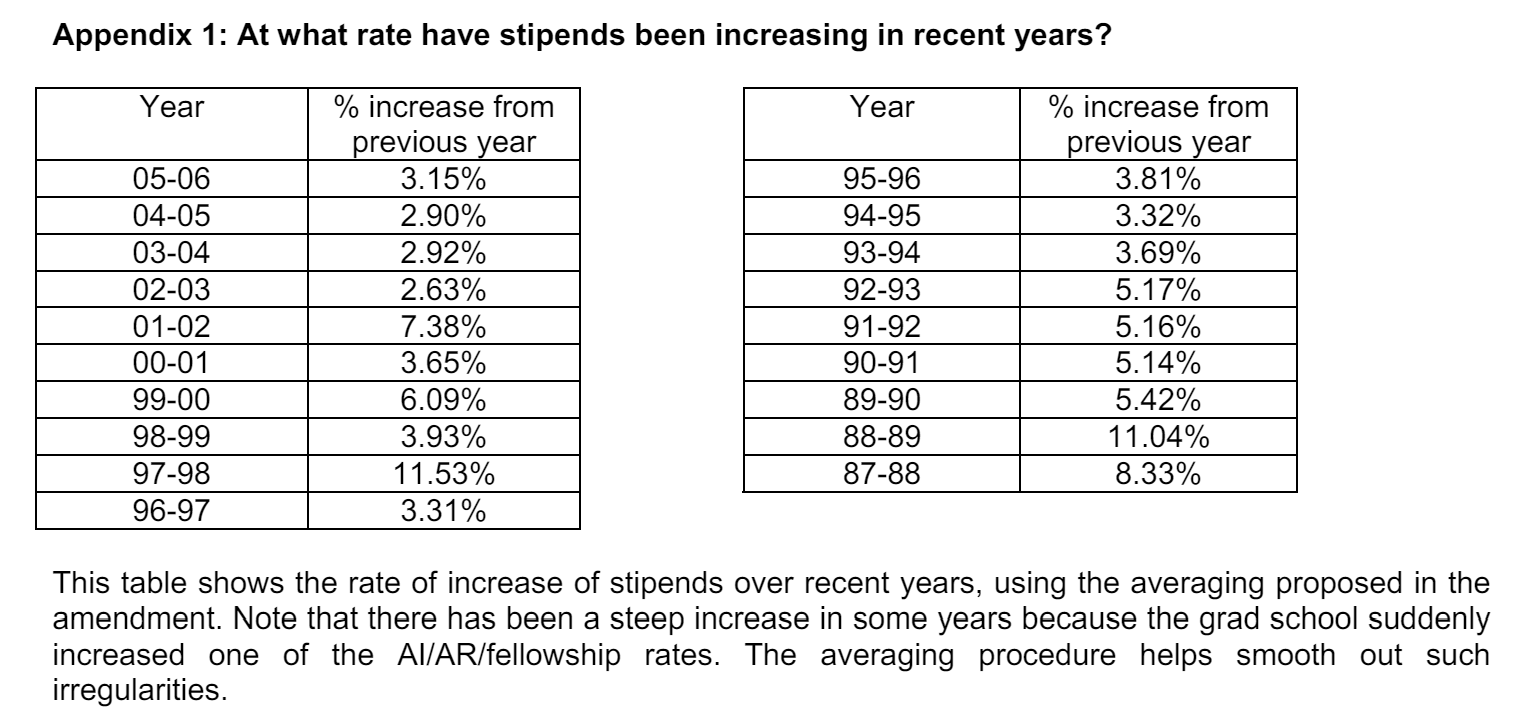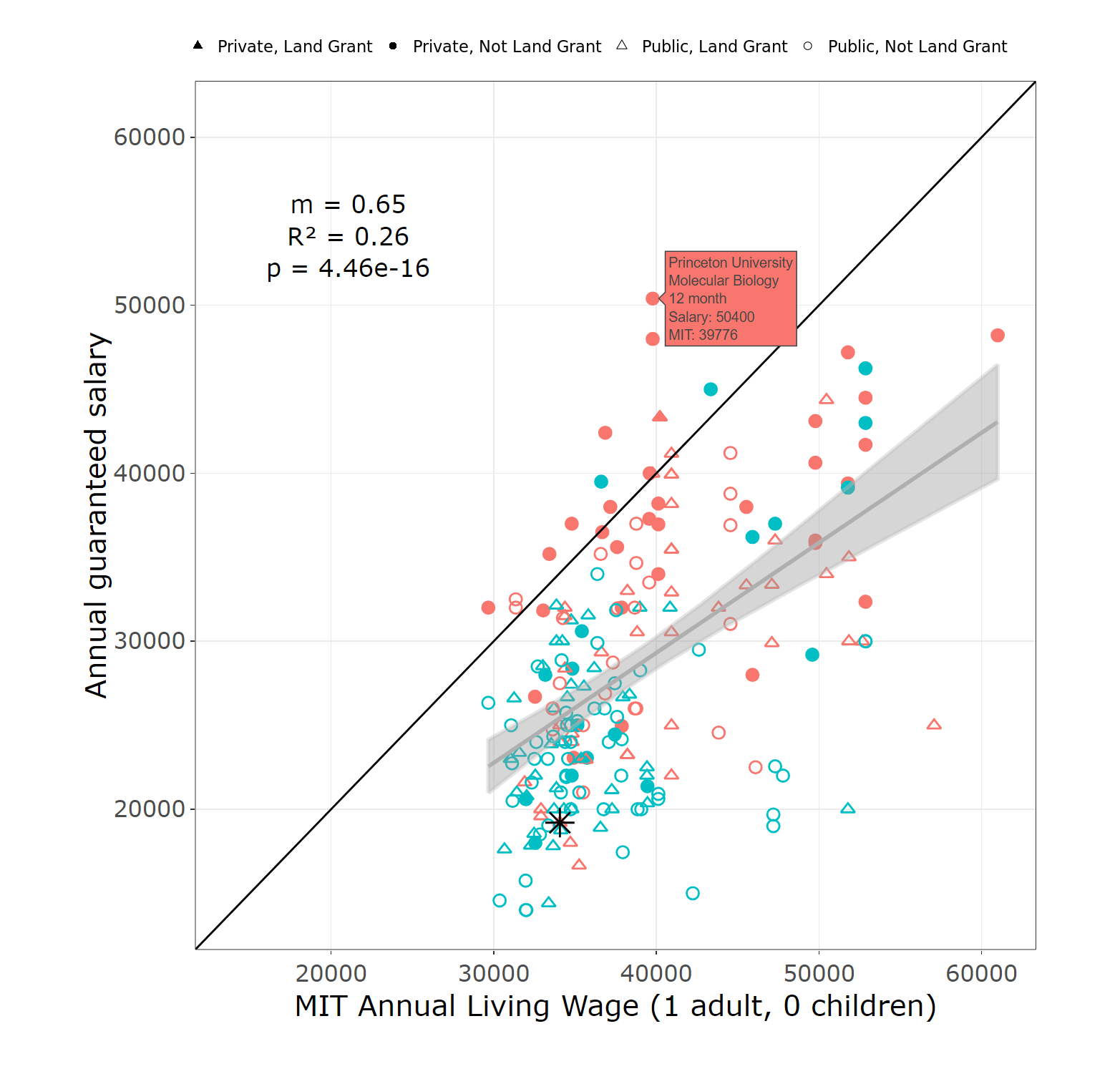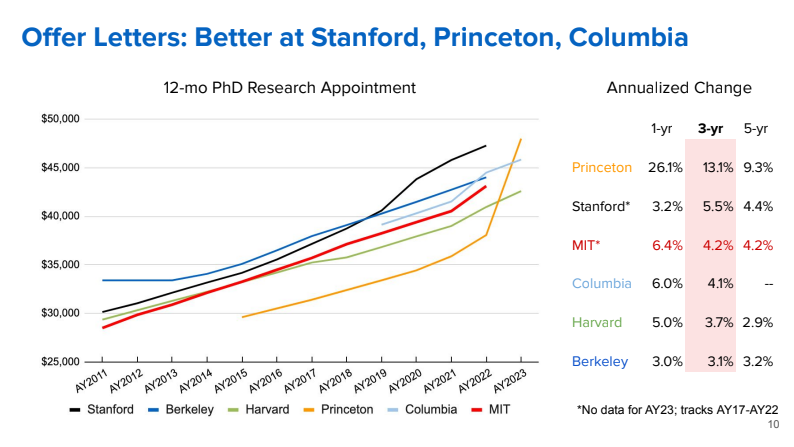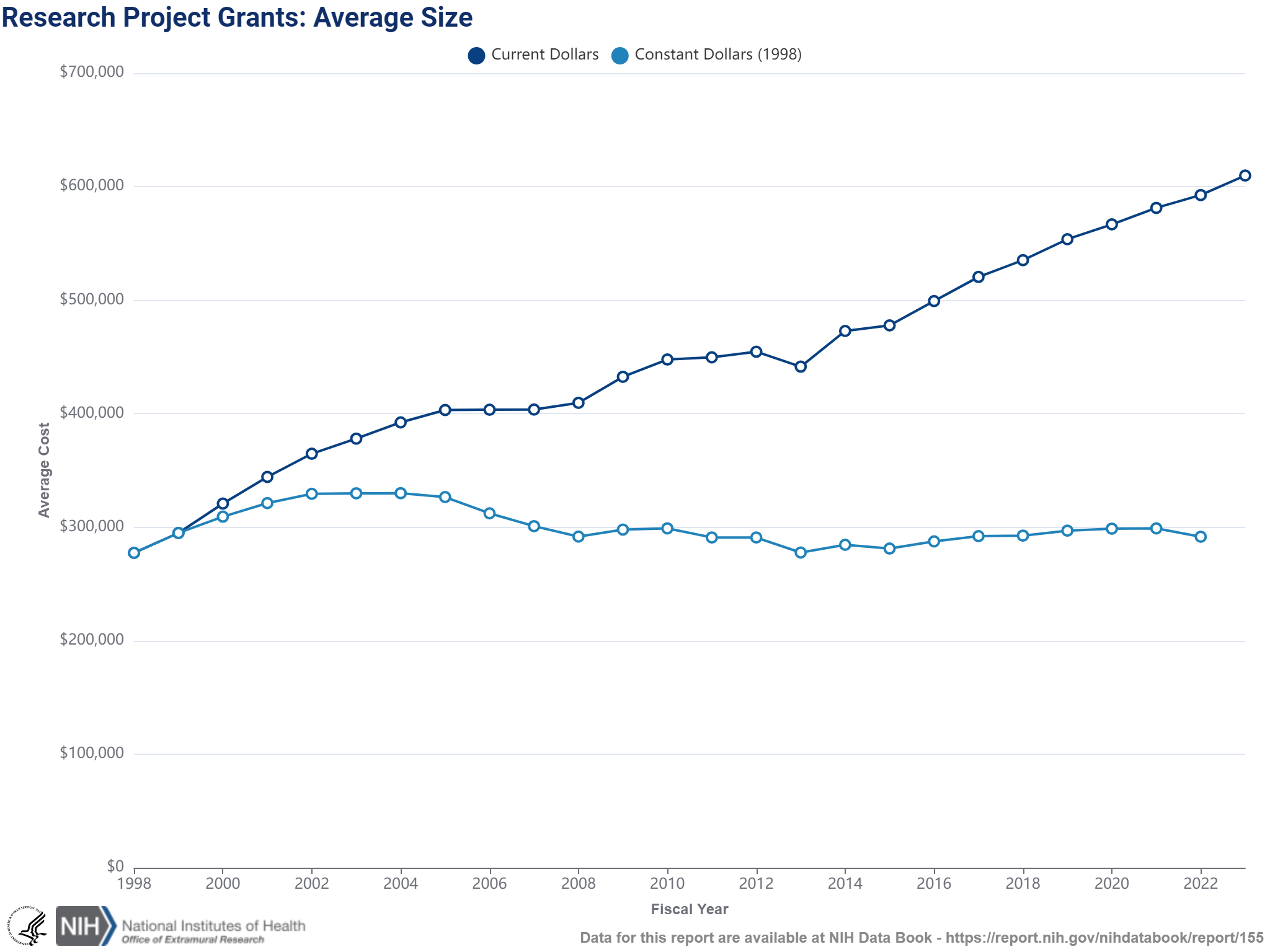Stipend
Everyone wants to be paid more, but to what extent can you actually get more from unionization?
All of the data, sources, and methodology used in this analysis are available in the data repository.
Table of contents
The Tales of Two Ivies
In April 2018, Harvard graduate student unionized under HGSU-UAW, with 1,931 in favor and 1,523 opposed, out of more than 5,000 eligible voters1. Cornell on the other hand, voted against unionization in 2017, with 941 in favor and 867 opposed2, out of the approximately 2,300 eligible voters.
HGSU-UAW secured their first contract in 2020, which included a 2.8% increase in stipend for Academic Year (AY) 20-213. Their second contract in 2021 included an annual stipend raise between 3% to 5% between AY21-22 and AY23-244. Between AY20-21 and AY23-24, the actual stipend average annual increase was 3.69%.
Cornell, on the other hand, had their stipend increases determined by the administrator over the same period. The stipend increase ranges from 2.2% to 8% between AY20-21 and AY23-24 with an average annual increase of 4.53%. Without unionization, Cornell’s average stipend increase exceeds that of Harvard between AY20-21 and AY23-24, as the HGSU’s 2021 contract was made when the inflation rate was low. This highlights one of the limitations of unionization in stipend increase.
Agreeing on collective bargaining through unionization means that the rate of stipend is determined far in advance, typically for 3 to 6 years, which can be inflexible in the face of economic uncertainty.
Conservative Stipend Increases in Ratified Contracts
Comparing the ratified graduate union contracts across multiple universities in the figure below shows that the agreed rates of stipend increase tend to be more conservative than the historical Princeton stipend increase rates. This is because universities that have graduate student unions have to follow the ratified contract even if the economic situation changes.
This is apparent in the long term with Temple University’s graduate student union TUGSA, where their long-term salary growths are significantly slower than Princeton’s non-unionized salary growth. Even if we include their recent strike gain in 2023, which gives them a 24.6% increase, the total percentage of stipend increase between AY02-03 to AY24-25 for Princeton is still much higher than the unionized Temple students.
For the universities, offering a higher stipend than their competitors is important as it gives them a competitive edge in attracting the best students. A competitive student will receive several acceptances from different universities when applying and the stipend is one of the important factors in their decision making process. Our Priorities Committee Reports confirm this as the main reason for our high stipend going as far as the 2007 report. Princeton commitment to high stipend actually goes all the way back to 1987 as shown by the data in GSG 2006 refrendum.

Another example, even though Harvard had already signed the contract with HGSU-UAW, they recently increased their stipend to $50,000 unilaterally5. Of course, the union took credit for the increase even though it was neither part of the contract nor the union’s demand, similar to what PGSU did in the past. In the similar vein, HGSU doubled down and demanded a further increase in stipend6.
If the union is still banking on the university self-imposed increases, then what is the point of unionization?
Contrary to PGSU’s claims, Princeton has consistently increased the stipend for the graduate students in the last decade. We currently have the highest stipend to the living wage ratio7 as shown in the figure below over 168 Universities in the US. The stipend increase for upcoming year at 4.25% cemented this position8.
 Biology Ph.D. Stipend Data retrieved 2024-05-077
Biology Ph.D. Stipend Data retrieved 2024-05-077
Union also cannot guarantee that the stipend increase will be higher than the historical average. Based on the MIT equivalence of their priority committee report, right before unionization in AY22-23 graduate students received a 9% increase from the 7.4% recommendation. Even before this, they were getting 4.5% average over 5 years.
Now, with the union they are getting only a 3.5% raise for the next two years. Their initial increase of 5.4% (equivalent to 3.96% after union dues) is still under their previous 5-year average.
 MIT GSC Stipends Committee 2022 Report retrieved 2024-05-099
MIT GSC Stipends Committee 2022 Report retrieved 2024-05-099
There is no guarantee that we can get a higher stipend increase rate through unionization in Princeton, as evidences from other universities suggest otherwise.
Funding Sources and Limitations
There are three main sources of funding for graduate students in Princeton or any other universities: Fellowships, Assistantship in Research (AR), and Assistantship in Instruction (AI)10.
Assistantship in Instruction (AI)
Unlike most universities, Princeton does not allow graduate students to lead their own courses. Graduate students can only be a preceptor or a grader. This means that the AI funding is restricted by the number of courses available. In addition, some courses will not require any AI assistance at all.
While all AI stipends are provided by the university, it cannot be significantly higher than the AR stipend. Currently the AI stipend is slightly higher than the AR stipend, but there was a time when the two were equal.
Assistantship in Research (AR)
AR is perhaps the most common form of funding in Princeton, especially for the STEM students who constitute the majority of the bargaining unit in this upcoming election11. This funding is typically provided by their advisors’ grants. Based on the data from the National Center for Education Statistics, the Department of Health and Human Services (HHS) is the largest funding source for research grants at universities, surpassing the National Science Foundation (NSF), Department of Defense (DoD), and Department of Education (DoE)12.
To illustrate the limitations on stipend growth due to grant growth, we will use the data from the National Institutes of Health (NIH) budget which is the research funding agency under HHS. The NIH grant imposes two main constraints on the stipend growth:
The NIH grant limits the amount of stipend that can be paid to the graduate students, including benefits costs, to the zeroth year postdoctoral stipend.13
For the current AY23-24, the zeroth year postdoctoral stipend is $56,484, which is really close to the current Princeton AR stipend of $50,400 before factoring any additional benefit costs, commonly referred to as the fringe rate.
The fringe rate is typically set by the university in negotation with the federal government and is typically around 30%, with 10% of it being allocated for retirement. Princeton is unique as it does not charge the health insurance as part of the fringe benefit, unlike most universities.
When the union demands higher benefits, this fringe rate will increase naturally as it needs to cover the additional benefits. The graduate union cannot negotiate the fringe rate as it is not a labor issue.
This means that the high stipend increase that the unions have achieved in other universities is not possible in Princeton, as we are already close to the limit of what can be paid out of the NIH grant.
The NIH budget has only increased by the inflation rate since 2008.
It is not hard to see that the rapid increase in graduate student stipend and the stagnation of research funding will lead to a decrease in the number of admitted students. This is because the university has to balance the number of admitted students with the available funding to keep their competitiveness among peer institutions.
A professor with limited grant funding will have to reduce the number of students they can take if the funding is not enough to support them to be competitive. To quote the Task Force Report on the Future of the Graduate School,
The average grant size and length have decreased and the number of training grant slots has decreased, while at the same time costs have continued to increase.
Fellowships
Fellowships are awarded by either Princeton or external organizations. Students under fellowships are not part of the bargaining unit in this upcoming election. This is partly because of its nature that is akin to a scholarship and not as a remuneration for labor.
For completeness, we will discuss the growth of external fellowship stipends, particularly the prestigious NSF Graduate Research Fellowship Program (GRFP)14 for STEM students. The stipend of NSF GRFP used to exceed the typical graduate student stipend in the US. However, in recent years, the value of the stipend has fallen behind the typical graduate student stipend in the US. In fact, it is now lower than the lowest stipend in the Ivy League.
-
March 2017 Union Recognition Election Results Certified; Union Loses, 941-867 ↩
-
Harvard Griffin GSAS application rise nearly 16% over past three years ↩
-
GSAS Raises Ph.D. Stipends to $50,000 - The Harvard Crimson ↩
-
Trustees set 2024-25 budget, increasing spending for undergraduate financial aid and graduate student support ↩
-
Information about Gradute Student Unionization - The Graduate School Princeton ↩
